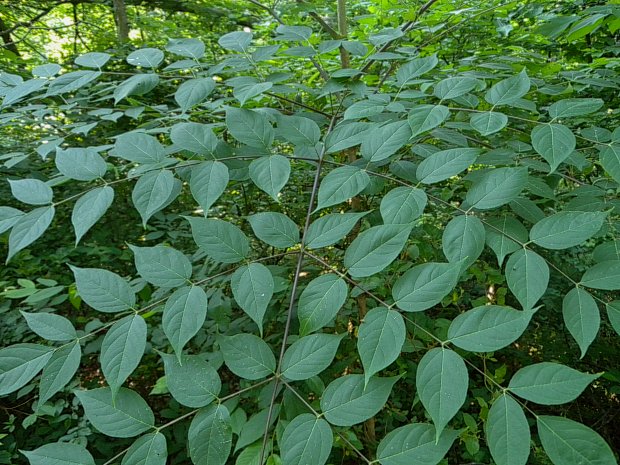Devil’s Walking Stick
(Aralia spinosa L.)
Description
Devil’s walking stick is a member of the ginseng family (Araliaceae). The common name and species epithet derive from sharp prickles on the plants stems and branches9. The genus name comes from an old French-Canadian name of “aralie”9, applied to a baby girl and means “one who is a born leader”10. This deciduous, woody species grows to a height between 10-15 feet tall as a shrub or multi-stemmed tree but can be a as tall as 35 feet2,9. The stout prickles grow as extensions from the epidermis are lost as the tree grows. Its mostly alternate leaves are pinnately to tripennately compound and may be up to 5 feet long and 4 feet wide9, making them amongst the largest leaves of native plants in North America4. Individual leaflets are up to 3 1/2 inches long8. The large leaves create a canopy in the shape of an umbrella4. The leaves are green during the summer and yellow to red in the fall. The flowers are a greenish-white color and cluster above the leaves. The fruits are fleshy purple-black berries about a quarter inch in diameter.

Stem of Devil’s walking stick with prickles. J. Brighton* 2021, Maryland Plant Atlas 11

Bipennate leaves of Devil’s walking stick8.
 Devil’s walking stick in flower. W. Longbottom 2021 (CC BY-NC), Maryland Biodiversity Project 5.
Devil’s walking stick in flower. W. Longbottom 2021 (CC BY-NC), Maryland Biodiversity Project 5.
Distribution
This tree is native to North America and commonly found in the Southeast. The most common areas to find the Devil’s walking stick is in fields, forests, wood margins, and moist woods2. This species grows best in areas sheltered from heavy winds. Areas with moist and fertile soil grows aralia spinosa well but it can tolerate rocky and clay areas2. The species grows quickly and spreads through self-seeding and sprouts. In most eastern areas of the United States, Devil’s walking stick grows upland and low woods, as well as the edges of woods3. In Maryland specifically, Devil’s walking stick can be found alongside the edges of forests of the following counties: Prince Georges, Allegany, Howard, Anne Arundel, Worcester, Kent, Caroline, St. Mary’s, Somerset, Talbot, Dorchester, Wicomico, Calvert, and Charles11.

Distribution of Devil’s Walking Stick, FEIS7.
Wildlife Importance
Devil’s walking stick supplies fruit for animals such as small mammals like chipmunks, foxes and raccoons, as well as songbird such as Cedar Waxwing, White-throated Sparrow, Swanson’s Thrush and Wood Thrush8. The berries also feed larger species such as black bears8. The nectar created in the flowers can be used by butterflies and insects. Since the bark is covered in sharp spines and prickly leaves, the species is avoided by deer and are not often infected by insects2. The flowers give many species food during blooming periods. Flowers are pollinated mainly by bees8and seeds are dispersed and germinated in the spring by wildlife.
Economic Importance
Aralia Spinosa is used for medicine, food, and furniture6. The dried leaves have many medicinal properties such as decoction of the dried cambium which increases the flow of saliva, syphilis is treated using its bark, and the root of the plant helps skin conditions such as eruptions and swelling6. Recipes such as potherb and adding the plant to side dishes like apples and onions are a common side dish. The leaves are eaten raw as well. The branches of Devil’s walking stick are straight and can be turned into walking sticks and canes. The wood is soft enough to make chairs and picture frame6.
Threats
The tree has few poisonous characteristics, but the use of prickles protects the tree from large herbivores such as elk4. Severe frosts can cause kill the stems and leaves to ground level during the winter season7. Human activity such as the use of roundup weed killer threatens the plants survival.
Interesting Facts
- The berries, bark, and roots of the Devil’s walking stick was used by Native Americans and European settlers as medicinal methods1,3.
- Devil’s walking stick has the largest leaves of all temperate trees in continental United States5.
- The leaves of Devil’s walking stick are used for curing issues of sub-anemic blood6.
- The dried leaves of Devil’s walking stick can be ingested and used as an antidepressant6.
References
- Jefferson Patterson Park & Museum: Devil’s Walking Stick
- North Carolina State Extension: Aralia spinosa
- Virginia Native Plant Society: Devil’s Walking Stick
- Janis Piotrowski, Tallahassee Democrat, Home & Garden
- Maryland Biodiversity Project: Devil’s walking stick
- Only Foods: Aralia spinosa
- USDA, Forest Service, Fire Effects Information Service: Aralia spinosa
- Illinois Wildflowers: Aralia spinosa
- Missouri Botanical Garden, Plant Finder: Aralia spinosa
- Schoolmykids
- Maryland Plant Atlas: Aralia spinosa
Contributed by O. Collins
* Image used with permission of photographer.
Towson University Glen Arboretum
